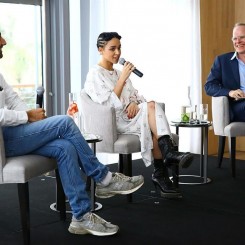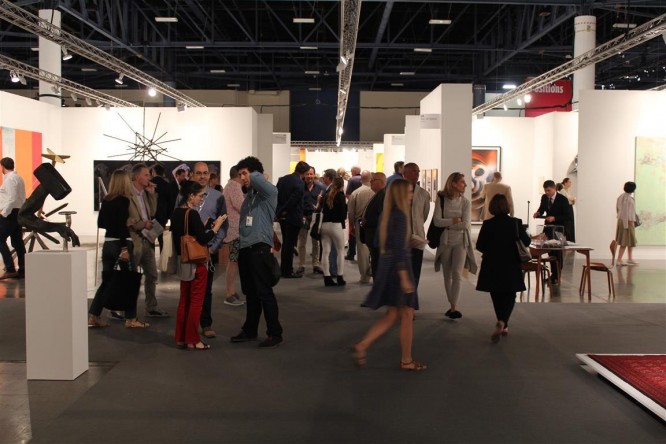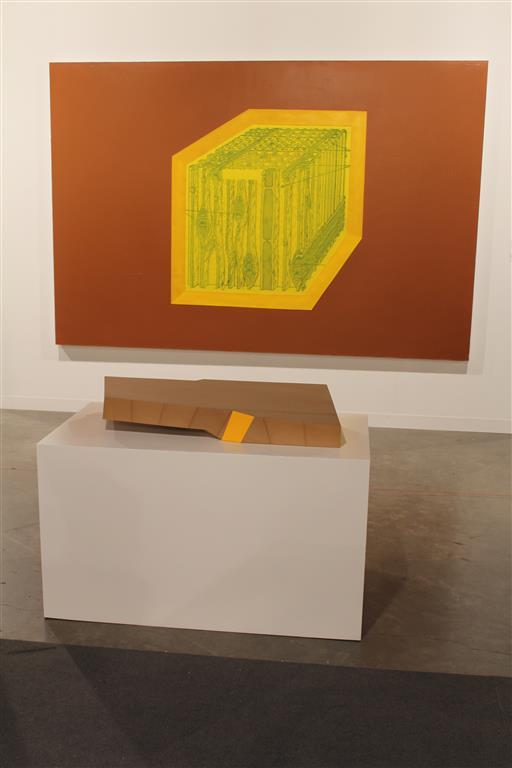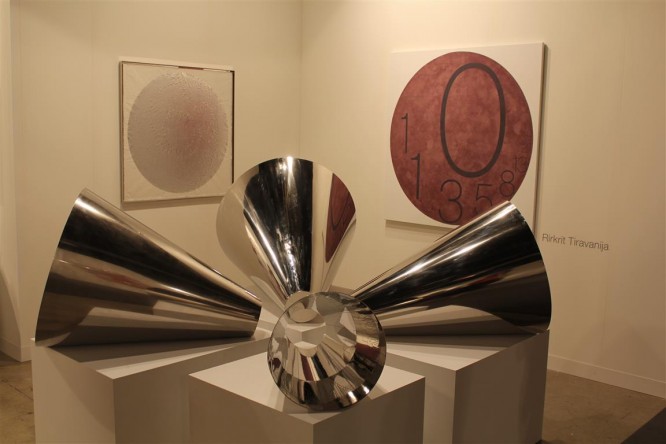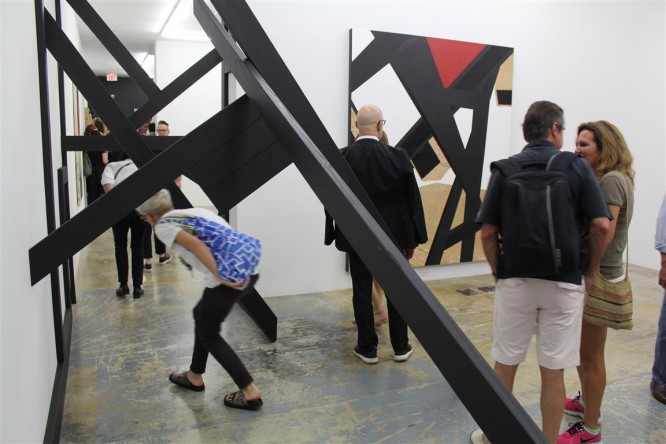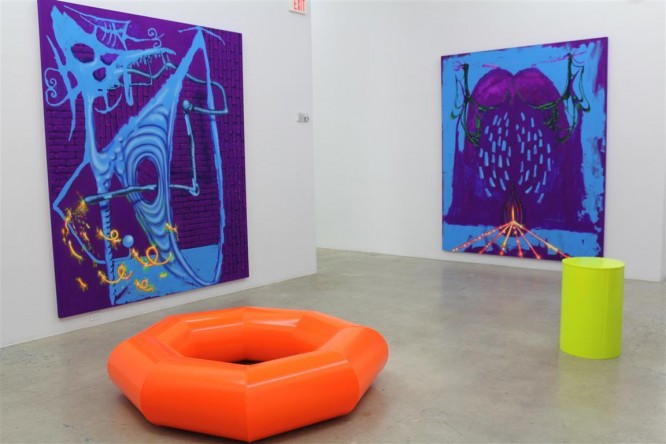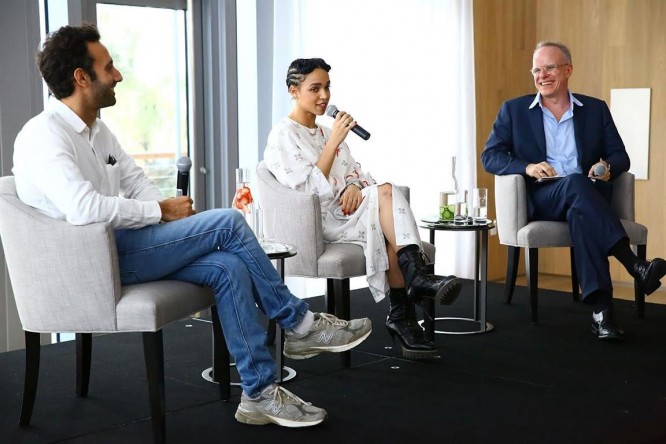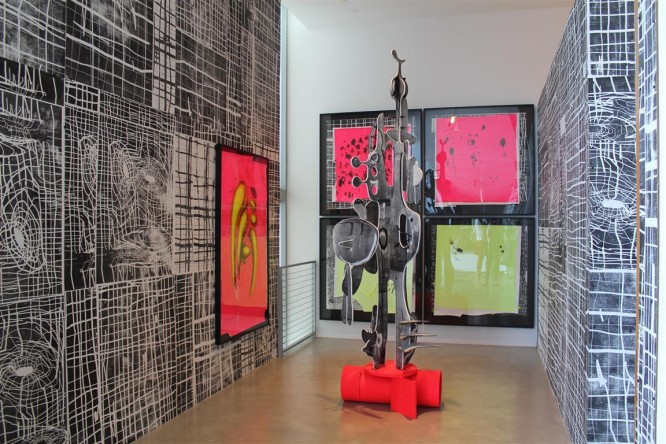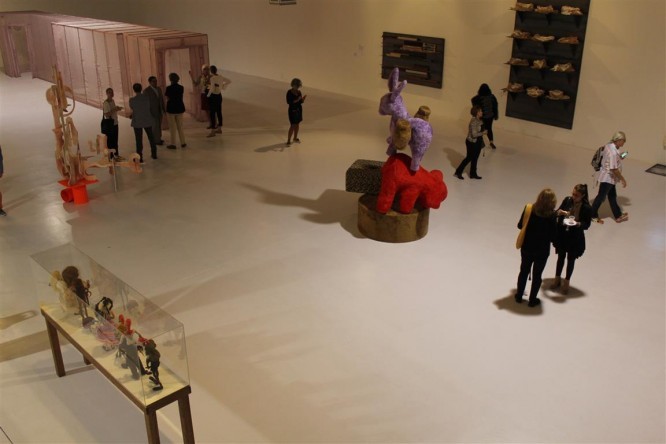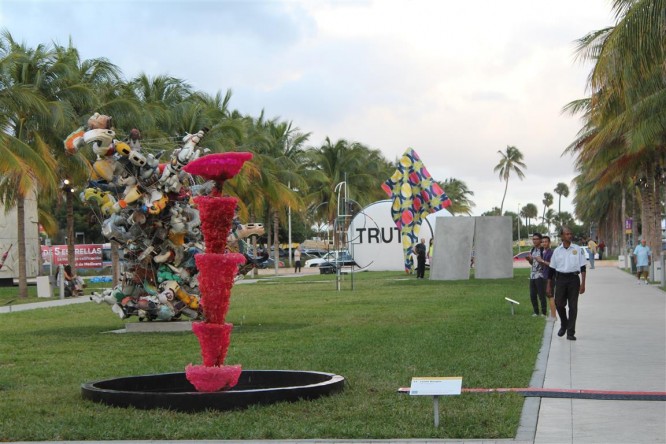Art Basel Miami Beach has closed its 2014 edition. The reports were again positive—no surprises there. This fair offers an opportunity for galleries to display more conservative stock to an audience less geared to challenging work than those in Basel proper might be; the crowd was certainly not what one might call “cosmopolitan”. Art Basel Miami beach is traditionally seen as the glitzy, snowbird relative of Basel proper (“We’re in the weirdest city in the world,” one European gallerist was heard to remark during the VIP opening), with attendees in significant part accounted for by East-Coasters flying South for the winter, their leisure time and money conspicuous under the glare of the Miami sun. Signs of change are in the air, however, for Miami’s reputation.
But first—the sales. American galleries expect to make a killing at this fair, and all signs show that they did. Upbeat reps at Simon Lee reported excellent sales of paintings by Merlin Carpenter, having sold five pieces brought to the fair and a further ten from London. Melanie Baker also sold well in an edition of Basel Miami which the gallery felt “surpassed expectations,” dispatching works they had—and had not—expected to sell. Jack Shainman of the eponymous New York gallery was pleased, too, having “sold more than half of our stand in the first few hours”.
The expats were not disappointed, either. Thaddaeus Ropac might as well have been describing Olympic sprinters when he said, “The American collectors showed strengths almost unseen before—they were very focused and very determined, exhibiting fast decision-making and a curious and positive mindset.” According to Art Market Monitor, they sold a 2013 Georg Baselitz bronze entitled “Louise Fuller” to an American collector for $2 million. Galerie Urs Meile sold a recent installment of the ongoing photographic series “Narrative by a Pile of Clay” by young artist Hu Qingyan on the first day, as well as a large 2014 painting by Wang Xingwei, “Untitled (Pan Changjiang)”, early on in the fair. Three works by Li Gang were also sold to separate collectors. Long March Space made good use of the current solo exhibition by represented artist Wang Jianwei at the Guggenheim in New York, bringing a painting and two small sculptures, both of which were sold (to collectors in the US and China). They also sold a large painting “Meditation No. 8” (2014) by Liu Wei, and a Xu Zhen by MadeIn Company piece (“Under Heaven-2632JP1403″). The Singapore Tyler Print Institute (STPI) was pleased with the level of engagement from visitors with the “Time Traveler’s Chronicle” project by Rirkrit Tiravanija, of which this was the first US showing. A striking sculptural formation of four metal cones from this series adorned the front of the booth. Lisson gallery, which will open its New York branch in 2015, was also very positive. Before the fair was up, its representatives remarked that the jury was merely out as to whether this year in Miami was good, really good, or excellent, and pitched their own success at the level of “very good”. One suspects that the sale of the Ai Weiwei’s “Jade Handcuffs” for 70,000 Euros may have clinched the top-level verdict. As usual, some memorable sound bites were to be heard around the fair—“I’m just looking for Picassos,” remarked one punter, whom we presume missed the opportunity to buy a ceramic plate entitled “Visage aux Mains” (1956; $85,000) before it was swiped from Leslie Smith’s booth in the Art Miami fair (not Art Basel Miami Beach) by thieves on Thursday.
The consensus was that the new VIP opening structure worked well, allowing galleries more time to communicate with a slightly stemmed flow of collectors on the first day. Nonetheless, the galleries section was relentlessly packed with stalls, and the VIP lounge often crowded to the maximum. Welcome respite could be found at the satellite fairs, however, of which NADA (the “anti-Basel” fair) was among the best. Participants here also reported very strong sales, and it was a pleasure to peruse this quieter, edgier spot after the high-strung atmosphere at Basel.
While sales maintained the high level of last year, a more interesting development is afoot in the wider culture of Miami. Basel Miami Beach is a fair which does not have a strong curatorial imperative—to date, its very direct commercialism has matched the local context. The booths arrangements are straightforward, not subtle. There are no overbearing or difficult installations to be found breaking up the web of gallery stalls, and sections such as “Kabinett” and “Positions” serve merely as light focal points in a mass of disparate works on view. Beyond the December booths, Miami’s public museums are not known for strong contemporary exhibitions, seeming to cater to somewhat bland expectations. Meanwhile, numerous private collections make no secret of where much of the art fair’s stock ends up, and reveal a highly competitive collecting culture (at the Rubells’ opening, someone gestured at a vacuum cleaner affixed to the wall, exclaiming “Look at this Jeff Koons! I have the towel dispenser, but this is much better.”) Indeed, a walk round the de la Cruz or Margulies spaces can feel not unlike being inside a huge art fair booth, surrounded by grand works in no particular order; a peek into curtained-off rooms in these voluminous temples reveals piles more canvases and crates. Occasions like the Rubells’ eccentric 50-strong cake-eating anniversary event, too, bolster a culture of performance and attention among the area’s conspicuous art-buying class.
The new Perez Art Museum (PAMM, formerly Miami Art Museum), however, signals a new turn for institutional culture in Miami. 200,000 sq. feet (18 580 sqm) of exhibition space fills a Herzog & de Meuron structure overlooking Biscayne Bay, close to the Wynwood district where galleries and private collections hover among low-rise residential streets and graffiti-marked warehouses. The opening on December 4 was rammed. The exhibition “Global Positioning Systems” is a huge display incorporating 100+ works (both on loan and drawn from the museum’s holdings) which examines the intersection between history and globalization. The Chief Curator Tobias Ostrander (whose experience spans roles in São Paulo for the Biennial and in New York at the Brooklyn Museum of Art and MoMA, among others) has orchestrated thoughtful, broad, and often unfamiliar selections. Here is an exhibition engaged with historical and socio-political contexts which does not seek only to please the eye. What this level of engagement means is the chance for Miami to participate in international exhibition culture—rather than remaining locked in its own acute commercial zone. With a museum to be proud of, the city might shed its status as an annual time-share for contemporary art followers to become a worthy location on the global exhibition map. The opportunity is certainly there. The presence of the Perez alongside Miami’s ICA and CIFO (the Cisneros Fontanals Art Foundation), currently showing a very good abstract exhibition called “Impulse, Reason, Sense, Conflict” signals real potential. Watch these spaces.
Of course, there were many, many parties. Jeffrey Deitch declared Miley Cyrus “the real deal” (“This year has constantly challenged me, and that’s why I started doing art,” she announced between spandex breaths on Wednesday night), and the HUO hosted talks with sexy musicians and artists about Instagram. Celebrities colonized the brand new, all-white Edition hotel, and Drake apparently took a beating from P Diddy in a club over a girl. But enough of that. Miami has its vices. But virtue is in the air, too.

